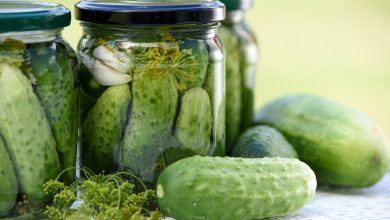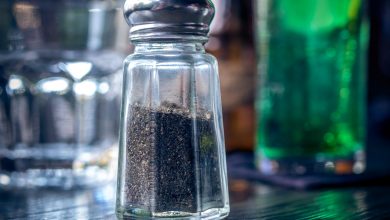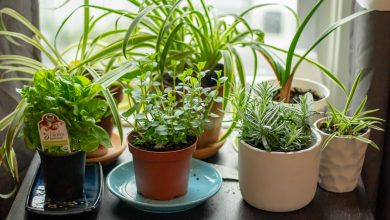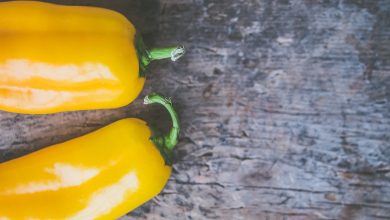How to Grow Tomatoes
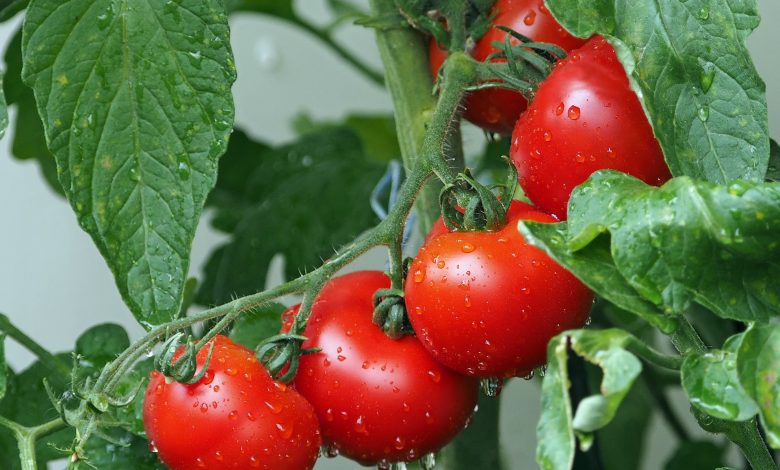
Before you start planting, you will need to know how to care for these plants properly.
Tomatoes don’t like stuffy storage spaces. Don’t just drop them off in a closet, hoping it sorts itself out with minimal intervention. The plant will die in protest, even if only to spite its owner. Ensure the tomato plants get proper air circulation and warmth.
Crowded spaces stifle tomato growth, so additionally, you’ll need to make sure multiple plants have enough space to grow without getting in each other’s way.
Good airflow also has another purpose, which is strengthening the stem to handle the hopefully-bulbous fruits it’ll soon develop. Before you mulch your tomatoes, ruffle the top of the plant’s base. This will help you make sure that the soil isn’t too compacted and will allow your plants to get enough air and water.
Ensure the seedling gets sufficient lighting as well. Leaving them to bask in the sun is a good idea. However, for areas with shorter days, artificial lighting may be necessary. A good rule of thumb for plant light exposure would be to make sure that they receive between twelve to fifteen hours of sunlight in a given day.
For artificial lighting, you want to hang some fluorescents right over the bloom. Three inches is a reasonable margin of distance, and simply move it up and away as the plant grows. Any further than three inches could lead to lankier growths, which in turn leads to less desirable yields.
Proper watering is also essential. Watering is only needed once a day, though different climates may require different schedules. A good rule of thumb is watering at the stem to minimize runoff water and avoid drowning the poor thing (like people, roots need to breathe too!). Another important thing to keep in mind is to never water tomato plants at night, as due to the moister environment, it’s easy to overshoot and drown your plant, coupled with the increased risk of the seedling contracting a disease.
Types of Tomato Plants

While you can divide the different types of tomatoes into many categories based on a whole plethora of identifiable features, the most important one for you, the grower, would be their growth type: cordon or bush.
Cordon (alternatively: upright/indeterminate)
Cordon tomatoes grow upright, based on a single stem. These types of plants are a bit more high-maintenance than bush tomatoes. Cordon tomatoes need growth stop-offs, side-shoot removal, and general trimming – especially at the bottom leaves, which we’ll touch on a bit later in this article. Strong staking is a necessity if you want to cultivate cordons properly. Some variants can grow up to an average of two meters tall, with some even reaching up to four meters!
Bush (alternatively: determinate)
Bush tomatoes grow across, in a cluster – hence the name. This type is relatively small by comparison to cordon tomatoes, as its height caps out at around five feet high, with most variants peaking at no more than knee level and rarely above the waist. Bush tomatoes are easier to maintain for a gardener with less time on their hands. They are capable of thriving even in semi-constrained environments such as plastic containers. Bush tomatoes boast a shorter growing period and produce fewer leaves to trim. Some gardeners believe the taste to be less notable than indeterminate variants, but this is entirely a person to person preference. One thing to consider is the plant’s proximity to the ground, putting it at risk for disease, weed saturation, or insect infestation, exacerbated by the shrubbery’s notable width.
Growing Tomatoes: From Planting to Harvesting
Growing Tomatoes from Seed
Having the ability to grow tomatoes of any kind is a great benefit, but growing them from seed provides a much larger list of varieties to choose from. From seed, gardeners can incorporate specialty or heirloom tomatoes, as well as unique breeds.
In seed form, tomatoes are available in hundreds of different varieties. You’ll see a range of sizes, colors, and flavors, including some that are small, yellow, and fuzzy, while others are large, smooth, and blend from red to green.
Planting Tomato Seeds
If you want to grow tomatoes in your garden, it’s best to start them indoors six to eight weeks before you plan to plant them outside. If you’re in an area that gets frost, you’ll want to wait two to three weeks after the last frost before you plant them outside.
That being said, these tomatoes should be planted indoors four to six weeks before you see the last frost.
To begin, you’ll have a few different options when it comes to your soil. For best results, choose from damp potting soil, seed-starting soil, or peat pellets. The key thing here is that the soil is moist, but not soggy. In each small pot, plant two seeds to ensure that at least one of them germinates.
Depending on the type of tomatoes you’re growing, you’ll have varying seed sizes. You’ll want to place the seeds three times deeper than the seed size you have. These pots should be placed in a warm location; some heat from beneath is ideal as well. If you don’t have something like a heating pad, consider placing the pots on top of an appliance like the fridge, which will release some heat.
Within one to two weeks you should see some activity with your tomato seeds. The colder their environment is, the longer they are going to take.
Raising Tomato Seedlings
As soon as you start to see some activity, you can remove the small pots from the heat source. However, be sure to keep them in a room that is warm. Bright light is important, and the soil should continue to be kept moist.
Water the seedlings to keep the soil moist; try to avoid watering the actual seedlings, as they will still be frail at this point. Once some actual leaves are showing on your tomato plant, now it is ready for water-soluble fertilizer.
Issues with seedlings are as follows:
- Stretching: If your tomato seedlings seem to be stretching away from their pot and are becoming leggy, then they need to be closer to the sun. This happens to almost all plants if they are not getting enough sunshine, and it makes them weaker
- Purpling: If your tomato seedlings begin to change to a purple color, this means they need more adequate amounts of fertilizer. Apply fertilizer again at quarter strength.
- Damping-off: This is a term that refers to seedlings dying quickly and without warning. This is often caused by a soil-borne fungus. To avoid this, you can use fungicides in the soil after planting.

How to Plant Tomato Plants
If you live in a warm region, you’ll be able to plant your tomato seeds right into the ground. In cooler climates, you’ll be transplanting the tomatoes from indoors.
If you’re transplanting, you’ll know your plants are ready when they are standing tall and strong, and when they have at least a handful of large leaves.
The roots of a tomato plant grow right along their stems, which means you’ll want to plant them fairly deep into the soil to protect those roots. Depending on the strength of your plant, you’ll want to either stake or cage them for support. If they’re strong enough they can be planted without.
The Different Styles Of Tomato Planting
Staking
Another critical aspect of tomato cultivation is the necessity of staking – providing support to a plant’s stem using a variety of means. Tomatoes aren’t known for their sturdy stems, necessitating either a running fan or direct human intervention (e.g. “head pats”) to develop correctly, even without their produce weighing them down. Drooping tomato plants are also prone to infections, having their fruits picked apart by hungry insects, or simply dropping altogether with a resoundingly disappointing splat.
Luckily, we can stake the tomato plants. Several staking methods can be utilized to support your plants. Let’s just cover a couple of them to give you a head start.
Single Stake
A common way, especially for indeterminate tomatoes, is the single stake. A wooden stake – bamboo for lighter variants – is shoved into the earth near the plant, which is tethered to the stake at the stem with cloth strings as it grows. It’s essential to do this early in the tomato’s life or you’ll risk damaging the ever-important roots.
In the beginning, this is likely to look comical, but you should include a four-foot pole in the ground to ensure your plants do not fall over due to their ridiculous growth. Trust us when we say that this is a far better option than having to constantly monitor your plants, only to find them keeled over one rainy day.
Weave Staking
Another method is the weave staking approach, most useful when you’re growing a few tomato plants in one go. A boon of this arrangement is that strong stakes aren’t necessary, given the multiple stakes sharing the strain and burden. Simply set the stakes aside as a sort of fence, then tie a string around it in loops. And as the tomato plant grows, you can just add new rows to the structure. While it may seem a little tedious, you’ll thank yourself for your efforts once you consider the hassle of shoving a dozen wooden poles into the ground, each with their own nightmare of a maintenance schedule.
Grafting
A practical alternative to pulling off seed growth from scratch is grafting – the technique that essentially splices plant tissue to grow independently from their parent source. Tomatoes are among the most popular plants to graft, and multiple different grafting methods have emerged in the industry. Most of these can be done at home, given some experience and an online how-to guide.
Grafting joins two plants together, essentially turning them into a single organism in every respect. The process requires a scion and a rootstock, alongside the materials needed.
A scion is the grafted plant’s production base, in charge of any blooms, yields, stems, and flowers. It is often – but not necessarily always – the top part of the new plant. Scions are chosen based on the ideal traits the cultivator wants, whether it be gorgeous flowers, strong bases, or delicious yields.
A rootstock is – as the name suggests – in charge of root production and supplying the scion with necessary nutrition to supplement its ideal traits. The top of the rootstock rests typically at ground level, though as usual exceptions abound. Rootstock selection is not as stringent as scion selection is. After all, any plant can produce nutrition for itself. This extends only to a general level, with particular needs that appeal only to the relatively experienced gardening expert. Rootstocks are produced through carefully managed cultivation, backed by months upon months of research.
Approach Graft
An approach graft can occur naturally, such as when branches rubbed against one another merge together. This graft joins whole living plants together. To do this, one requires two plants naturally growing towards one another. You can manufacture this, if necessary. Simply rearrange the desired specimens. While dependent on natural growth, this method is one of the more manageable means, naturally healing over time. Don’t forget to provide aftercare, however, to minimize recovery time.
Cleft Graft
A cleft graft is a bit more complicated, needing a bit of blade work and patience. You’ll need two pairs of blades – a grafting knife and a heavy, cleaver-like cutter. A mallet is also a necessary utensil in this task. To begin, one needs to cleave into the rootstock. Position the knife and mallet accordingly and drive a wedge into the rootstock. Once this is complete, slice a wedge into the scion’s base. Keep in mind; this is rather delicate, so proceed with caution.
Join the scions and the rootstock at their tapered edge and cleft, respectively. After this, seal the pair at their joining. Soil works well for this purpose, though wax could be substituted for your ease. Additional support – such as sticks or thin string – are useful to have, though not strictly necessary. If one chooses to use two scions, follow up on their growth while providing aftercare. At a certain point, remove the weaker scion to provide nutrition for the better-growing one.
Tube Graft
A tube graft is quite simple, only needing a small silicone tube to join the plants. Simply slice the rootstock in the middle, then join the two plants. This approach is also known as Japanese Top-Grafting, as the process is somewhat similar to its parent variant.
Garden Methods

Traditional Garden
You could plant tomatoes in a traditional soil garden, as most people looking to grow tomatoes at home do. After all, it has a few perks to it. One of the biggest ones is the freedom to plant anything, even the colossal cordon variants that can outgrow humans in size. Less water is needed as well, due to existing moisture coupled with natural rainfall. Ground-level gardens are notable for producing excellent yields due to the abundance of natural minerals in the soil, which can be imitated but not entirely replicated with other potted variants. Lastly, over-watering is less of a concern. It’s rather hard to flood plants at that scale (at least on accident).
This method does have a few notable drawbacks though, chief among them are problems with aeration due to soil compaction. Another concern is the ground-level growth, putting them in very close proximity to animals that will happily gnaw your plant to tiny bits before the first tomato grows. Also, if soil-borne infections come around, the situation can’t be dealt with efficiently anymore. It could be a total uproot, at the least. The worst-case scenario is weeks of hard work down the drain, which would be heart-breaking.
Raised Beds
Raised beds are a fantastic option, with excellent drainage to minimize over-watering. The soil-borne diseases won’t be as crippling with this method, being rather easy to swap out should samples be tainted. Soil compaction isn’t a concern either – unless you’ve got plenty of small animals or children. And in that case, there would be more significant concerns than trodden soil anyway. Soil replacement is also suitable for allowing steady means of nutrition replenishment for your budding harvest. And over-top of this, raised beds are entirely modular and very aesthetically pleasing for most gardens.
The problem with this arrangement is, of course, price. Raised beds aren’t just an investment, but a significant one that will require quite a few resources and a lot of dedication to get started with. Because these are marketed with specific purposes in mind, the price tag alone might make people uncomfortable – especially if it’s their first attempt at growing tomatoes in this manner. Another concern is the large amount of space that raised beds can take up. This makes them a pretty undesirable option for people with limited garden space.
Container Garden
When it comes to container-grown tomatoes, one of the least expensive options are buckets, which are not only cheap, but rarely have to be purpose-bought. An old tub or even something like a large paint can work just as well. As long as the container can provide for enough growth-room, your plant should thrive. If worst comes to worst, this will be one of the easiest options to scrounge up, and it’s not even a bad idea. Just make sure that you poke some holes into the bottom to allow some semblance of drainage.
When it comes to composition, though, problems can happen. For example, with paint cans in particular, leftover chemicals from the paint you were storing in there can easily pollute your plant. Dark, metal buckets are also prone to overheating, effectively cooking the plant – roots and all. Indeterminate tomatoes are also off the table with this option, due to their sheer bulk. And it’s needless to say that this isn’t exactly the most aesthetically pleasing grow-op either.
Hanging containers, such as baskets, are a good alternative when it comes to the looks of your garden, which can provide for a nice way to get into building a vertical garden as well. One could quickly turn a hanging tomato basket into the centerpiece of their grow-op. And it also allows you to stretch and pluck rather than stoop and reach for your harvest.
However, if you’re not careful, this avant-garde presentation could quickly (and literally) come crashing down on your aspirations – and head. The container planting method couples well with growing cascading tomatoes, but one should remain wary of the risks and constraints involved.
How Far Apart Do I Plant Tomatoes?
Tomatoes will need a little bit of breathing room, especially if you’ve gone with larger varieties. As a golden rule, if you’re working with cages, your plants will need to be planted at least three feet apart.
If you’re using a stake, this will take us less room. Generally, these tomato plants only need two feet of space between them to grow properly. Whether you’re using stakes or cages, make the decision when the tomatoes are very young. This will avoid you sliding in stakes later on and harming the root system.
If you’re planning to let your tomato garden grow naturally, it’s helpful to leave three feet between the plants and a good five feet between rows. This way the plants can crawl around without obstacles.

Caring for Tomato Plants
Fertilizer
Once your tomato garden is planted, applying fertilizer is important. Tomatoes love to eat throughout the year, and they’ll do best when they are given a nice supply of nutrients.
Whether you go with an organic or chemical feeder, it will be easy to choose the type once you know what kind of soil you’re working with. As a general rule of thumb, soil that is high in nitrogen will need soil that is lower in nitrogen and higher in phosphorus. If your soil does not have much nitrogen, a balanced soil will do better. You’ll know you’ve used too much nitrogen if you’re getting very green leaves but hardly any tomatoes.
Fertilize your tomato garden as soon as its planted and then again when fruit begins to appear. When you’re first planting the tomatoes, dig the hole and mix the fertilizer in with the natural soil. Then, add a layer of regular soil on top. This will ensure that the roots don’t actually touch the fertilizer, which can burn them.
If you’re fertilizing when the plant is already bearing fruit, make sure the soil is very moist with water before adding any fertilizer. Try not to get any closer than six inches from the tomato plant stem to avoid burning.
Watering Tomato Plants
Watering your tomato plants shouldn’t be too complicated. You can base your watering schedule on how well the plant seems to be doing and what kind of weather you’re having.
During the warmest days of the summer, tomato gardens will need a good watering every two to three days. When the weather is a bit coolerand rain is more frequent, you can scale back to once a week.
Tips for watering tomatoes:
- Focus on the roots: Focus on watering at the base of the plant to get straight to the roots. It’s been found that watering the entire plant can attract pests that will begin to eat your plant.
- Mulch in dry spells: Mulch can help to keep moisture beneath the earth’s surface whenever the weather is dry. This can be helpful to your tomatoes if you’re going away and need the plant to stay hydrated.
- Water slowly: For some reason, tomatoes are a little pickier about how aggressively you water. Instead of using the full power of your hose, consider using a drip hose or some kind of irrigation system.
- Base it on your circumstances: There is no set amount of water that tomatoes need. This number varies from garden to garden, based on climate, soil, age of the plant, weekly rainfall, etc.
Pruning Tomato Plants
If you’re growing tomatoes in your garden, you might notice that your plants are beginning to become wild and unruly. This isn’t a bad thing, but it might have you wondering if you should be pruning your tomato plants and how to do it.
So do tomato plants need to be pruned? When it comes down to it, this is mostly the personal choice of the gardener. Some people swear that cutting back the tomato plant encourages healthy growth and production. In contrast, others believe that pruning can damage the plant to no benefit, and that the cutting only exposes the plant to disease and pests.
If you have decided that you do want to prune your tomato garden, you’ll want to make sure you do it the right way to avoid potential disease. There are a few rules to follow:
- Never begin to prune the plant before it reaches two to three feet in height. If they’re smaller than this, they may be too weak to recover from the damage.
- The term tomato suckers refers to specific spots on the plant. Look for the main branches growing off of the stem. Close to where these two points meet, other branches will be growing. These are the suckers that can be pruned.
- Always have a sharp pair of prunes for this job, otherwise, you could do additional damage.
- Prune early in the morning when there is no chance of rain. Dry weather is ideal for pruning since wounds are more susceptible to disease in wet conditions.
Common Diseases in Tomatoes
There are too many diseases that tomatoes face to list. The various issues are grouped into three categories: fungi-based, virus-based, and bacteria-based.
Fungi
The most common diseases in tomatoes are caused by fungi. They can be passed through the air or direct contact, and they can lie dormant for a long time before attacking.
The most common fungi disease in tomatoes is blight. Blight is separated into early blight, late blight, and septoria blight. This disease browns the leaves, leaves cankers on the stems, and creates target-shaped browning spots. It also rots the fruit.
Each version occurs at various stages of tomato growth. Septoria can be avoided by watering the roots and not the actual plant, while early blight can be avoided by burning any infected leaves and fruit. With late blight, the entire plant needs to be burned and disposed of.
Virus
The second most common cause of problems with tomatoes is virus-based bacteria. There are about a half-dozen viruses that can be found in tomatoes, and each of them causes stunted growth, rotted leaves, and inedible fruit.
One of the clear signs that a virus has infected your tomatoes is if the leaves are beginning to curl and lose their form.
As opposed to fungal treatments, there are no chemical solutions to treat a virus-based disease. Cleanliness is the best way to prevent these diseases, beginning with the planting area and the tools you use. Ensure the area is well-weeded and any pests are under control. If you see any infected plants, the best thing to do is to remove and burn them before they can spread their virus.
Bacteria
Bacterial wilt is one of the more devastating bacteria-based diseases in tomatoes. It is caused by a lack of water in stems and leaves.
While some bacteria can be scraped or flushed off of leaves, bacterial wilt begins in the roots and can be hard to track until it’s too late.
This bacterium clogs the transporting system of water through the plant and replaces it with a slime-like substance. There are no chemical control options for this issue; however, you can implement cultural controls.
This includes using raised garden beds, rotating the crops often, and washing both your hands and tools after handling the problem plants. In most cases, full removal of the plant will help protect the rest of the garden.
Harvesting Your Tomato Garden

When to Harvest
If this is your first time growing a tomato garden, you’ll quickly realize how tempting it is to want to harvest your tomatoes as soon as possible.
Even though grocery stores usually present us with bright red tomatoes for eating, this isn’t the best indication of when your personal tomatoes are ready to be harvested. In fact, if you wait for your tomatoes to resemble a bright red color, you could be way behind on the harvesting wagon!
What we mean is, tomatoes are super cool balls of gas. They emit a gas called ethylene, which begins when the tomato is fully formed and green. From the inside out, the gas begins to age the fruit faster. The tomato becomes softer, and the green color starts to fade. The ethylene increases the red and yellow coloring and removes the green coloring.
That being said, tomatoes are ready to be harvested when they are large and green. (We know, not what we’re used to seeing in the store!) However, harvesting at this time will help you to prevent any splitting or dropping, as well as having garden pests beat you to the punch!
If you’re not sure if you’re green tomatoes are ready, look for any small blush coloring to help you. Similarly, a softer tomato is ready to eat, while a harder tomato still needs some time.
If you’ve chosen a tomato variety that is far too large to ripen on the vine without breaking, you can bring these tomatoes inside and let them mature there. Smaller tomatoes will do fine to stay on the vine until they’re ready.
How to Harvest
Your tomatoes will first begin to show signs of color change at their base. This is especially true for larger varieties. You can gently squeeze the tomato to see if it has a softness to it.
Wrap your hand around the tomato and give a firm pull. You can use the other hand to hold the stem if you’d like as well. After you’ve collected your harvest, bring them indoors to complete their ripening process.
If you’re not ready for your tomatoes yet, store them in a cooler location. This will slow the ripening process. In contrast, store them in a warmer place to speed up the process.
Luckily, if you’re working with a range of different varieties, you might notice that some of your tomatoes ripen at different times throughout the summer. This is ideal since you can continue to cook with different flavors from spring to fall. Not to mention, some tomato plants will continue to cultivate more tomatoes even as you keep pulling them.
End of Season Tomato Plants
In their native habitats, tomatoes can grow like perennials; however, most of us are dealing with annuals that all face their last day. In most cases, tomatoes will begin to whither like the rest of your vegetable garden when frost is on its way.
If you want to get as many tomatoes as you can out of the last of your plant, cut back the water supply and stop using fertilizer. Some gardeners also remove the flowers so that the plant will focus on growing the food; however, these flowers can be good food for our pollinators.
To ripen the rest of the tomatoes, you can also choose to take the entire plant from the ground and hang it in a dry, dark space like your garage or basement (60-72 degrees Fahrenheit). The tomatoes will keep ripening here.
What to Do with Leftover Tomato Plants
Some gardeners have tried burying their tomato plants back into the garden over the winter. The idea is that they may pass their nutrients into next year’s soil. However, this isn’t a foolproof plan since the plants could be carrying disease or fungus that will survive into next year’s plants.
Another idea that doesn’t work very well is to put the plant into your compost pile. Here, the temperatures won’t be warm enough in the winter to properly break the plant down. Instead, the best thing you can do with your tomato plant is to toss it into your compost bin or a brown bag for pick-up.

The Tomato Options Are Endless
If you’re planning to grow tomatoes in your garden, prepare to be pleasantly surprised! Tomatoes are hardy, colorful, and delicious plants that will add some pizzazz to your garden, and your kitchen dishes as well!
With so many tomato varieties to choose from, you can experiment every season with a range of flavors and sizes. If you’re looking for some suggestions in terms of what seedlings to choose, we’d suggest Black Cherry Tomato, Chocolate Stripes, Black Krim, Green Zebra, and Yellow Peach.
Depending on your soil and climate, you’re likely to have a variety of breeds to choose from, each more delicious than the next. Don’t be afraid to explore with different kinds and find out which ones you like best.
